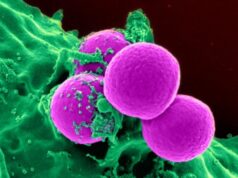A new study suggests there may be an overlap between rare genetic variations linked to bipolar disorder (BD) and those implicated in schizophrenia and autism.
The study, by researchers at the University of Iowa Carver College of Medicine, Johns Hopkins School of Medicine, and Cold Spring Harbor Laboratory and published recently in JAMA Psychiatry, adds to the growing understanding that many psychiatric diseases share genetic roots, but is among the first to suggest a genetic overlap between bipolar disorder and autism.
Bipolar disorder is one of the most important psychiatric illnesses because it is fairly common — affecting between 1 and 3 percent of the population — and quite debilitating. Although many patients are helped by treatments, such as lithium, about one third of people affected by BD do not do well with current therapies. Although it’s long been known that bipolar disorder is highly heritable, identifying specific genetic variants that contribute to the illness has proven difficult.
Within the last decade, advances in human genome studies have helped uncover several so-called common variations, but none of these variations alone have a large effect. Even more recently, the advent of rapid and relatively cheap next-generation gene sequencing technology has provided an opportunity to find rare variations that might individually have a large effect.
“Common variations are thought to each individually have only a tiny impact — for example, increasing a person’s likelihood of getting a disease by 10 to 20 percent,” says James Potash, MD, UI professor and DEO of psychiatry, and senior author of the new study. “The hope with rare variations is that they individually have a much bigger impact, like doubling or quadrupling risk for disease.”
Find your dream job in the space industry. Check our Space Job Board »
Potash and his colleagues devised a two-pronged strategy, combining a case-control approach with family-based exome sequencing to maximize their chances of identifying rare variants that contribute to BD.
The idea behind the case-control approach is simple: if a genetic variant is found more often in the group of individuals who have the disease compared to a control group of people without the condition, then the gene variation might be associated with increasing susceptibility to the disease. Very large datasets are key to the success of this approach.
Exome sequencing of families affected by a disease is more sophisticated. Comparing exome sequences of related individuals, affected and unaffected by BD, can distinguish variants that “travel with” or segregate with the disease. This approach has long been used to identify gene variants or mutations that are passed from parents to children that cause disease.
Overall the family study identified 84 rare variants (in 82 genes) that segregated with BD and that were also predicted to be damaging to the proteins encoded by those genes. The team then tested the likelihood that these rare variations might be involved in causing BD by looking for them in three large case-control datasets that included genome sequences from a total of 3,541 individuals with BD and 4,774 control patients.
Despite the relatively large size of the combined datasets, the approach was not powerful enough to identify any of the individual rare variants as definitively associated with BD. However, 19 genes stood out as being over-represented in BD cases compared to controls.
“The results were not strong enough for us to say ‘we have pinpointed the genetic culprits.’ But it was strong enough for us to remain interested in these genes as potential contributors to bipolar disorder,” says Potash, who also is the Paul W. Penningroth Professor and Chair of Psychiatry and a member of the Pappajohn Biomedical Institute at the UI.
However, when the team considered the 19 genes as a group, they realized that several were also members of groups of genes that had been implicated in autism and schizophrenia.
“It turned out that the schizophrenia and the autism genes were all more represented among our 82 genes than you would expect by chance,” Potash says. “And when we looked at our whittled down group of 19 genes, the autism genes continued to be unexpectedly prominent among them.
“With studies like this we are finally, after decades of effort, making real progress in nailing down groups of genes and variations in them that play a role in causing bipolar disorder,” Potash adds. “The mechanistic insights we gain from identifying associated genes we hope will point us in the direction of developing new treatments to make a difference for the many people affected by this illness.
Source: University of Iowa Health Care
Journal References:
- Fernando S. Goes, Mehdi Pirooznia, Jennifer S. Parla, Melissa Kramer, Elena Ghiban, Senem Mavruk, Yun-Ching Chen, Eric T. Monson, Virginia L. Willour, Rachel Karchin, Matthew Flickinger, Adam E. Locke, Shawn E. Levy, Laura J. Scott, Michael Boehnke, Eli Stahl, Jennifer L. Moran, Christina M. Hultman, Mikael Landén, Shaun M. Purcell, Pamela Sklar, Peter P. Zandi, W. Richard McCombie, James B. Potash. Exome Sequencing of Familial Bipolar Disorder. JAMA Psychiatry, 2016; DOI:10.1001/jamapsychiatry.2016.0251










